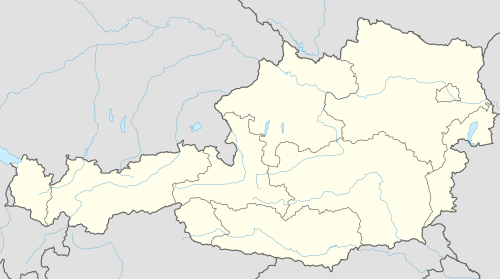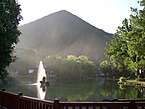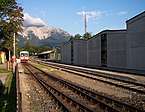Puchberg am Schneeberg
| Puchberg am Schneeberg | ||
|---|---|---|
|
| ||
| ||
 Puchberg am Schneeberg Location within Austria | ||
| Coordinates: 47°47′00″N 15°54′00″E / 47.78333°N 15.90000°ECoordinates: 47°47′00″N 15°54′00″E / 47.78333°N 15.90000°E | ||
| Country | Austria | |
| State | Lower Austria | |
| District | Neunkirchen | |
| Government | ||
| • Mayor | Michael Knabl (SPÖ) | |
| Area | ||
| • Total | 83.17 km2 (32.11 sq mi) | |
| Elevation | 585 m (1,919 ft) | |
| Population (1 January 2016)[1] | ||
| • Total | 2,660 | |
| • Density | 32/km2 (83/sq mi) | |
| Time zone | UTC+1 (CET) | |
| • Summer (DST) | UTC+2 (CEST) | |
| Postal codes | 2733, 2734, 2761 | |
| Area code | 02636 | |
| Vehicle registration | NK | |
| Website | www.puchberg.at | |
Puchberg am Schneeberg is a town in the south-eastern part of Lower Austria with approx. 2650 inhabitants. It is situated about 80 Kilometres from Vienna. The highest point of Puchberg is the Schneeberg with 2076 m, the highest mountain of Lower Austria.
Already in the 18th and the 19th centuries, Puchberg was a popular destination for visitors. With the opening of the Schneeberg Railway, tourism became more important than farming, which traditionally had been the primary source of revenue. The spa is one of the most famous tourist destinations in Lower Austria.
History
About its early history, little is known. A Roman road, on which grains, wine and salt were transported, passed through the area. The name Puchberg was first mentioned in 1260 in reference to Eberhard von Puchperch.[2] In the Middle Ages four castles were built near Puchberg, including Puchberg Castle, of which ruins remain.
The village was destroyed in 1683 by Ottoman forces at the time of the Battle of Vienna. With the opening of the railway from Wiener Neustadt and the rack railway to the Schneeberg in 1897, tourism became important. The region became a resort area for the Viennese upper classes seeking to escape the city in summer, and it still serves as a nature retreat today.
Subdivisions
- Puchberg am Schneeberg
- Rohrbachgraben
- Stolzenwörth
Sites of interest
- Puchberg Castle, the castle which was built around 1204. Its age was determined on the basis dendrochronological investigations at wooden remainders.
- School - where the philosopher Ludwig Wittgenstein was an elementary school teacher
- Schneeberg, the highest mountain in Niederosterreich, accessible with the Schneeberg rack railway. Schneeberg is also the site of the Empress Elisabeth Memorial Church, built in the memory of the Empress Elisabeth.
- The Lake - The heart of Puchberg's downtown is occupied by a lake surrounded by a path and landscaped flowers and plants. There is also an outdoor stage.
- There are two spas in Puchberg.
Image gallery
 View to mountain Schneeberg
View to mountain Schneeberg- Puchberg, seen from the Schneeberg
 Lake of Puchberg am Schneeberg
Lake of Puchberg am Schneeberg Railway station of Puchberg am Schneeberg
Railway station of Puchberg am Schneeberg Elisabeth church and Schneeberg Railway station on Schneeberg
Elisabeth church and Schneeberg Railway station on Schneeberg
References
| Wikimedia Commons has media related to Puchberg am Schneeberg. |
- ↑ Statistik Austria - Bevölkerung zu Jahresbeginn 2002-2016 nach Gemeinden (Gebietsstand 1.1.2016) for Puchberg am Schneeberg.
- ↑ Rainmund Rhomberg, Andreas Bichler in: Burgruine Puchberg am Schneeberg – Bauhistorische Analyse und Sanierung, Burgverein Puchberg, Puchberg, 2006, ISBN 3-85028-407-7
